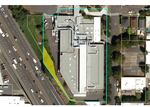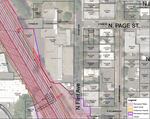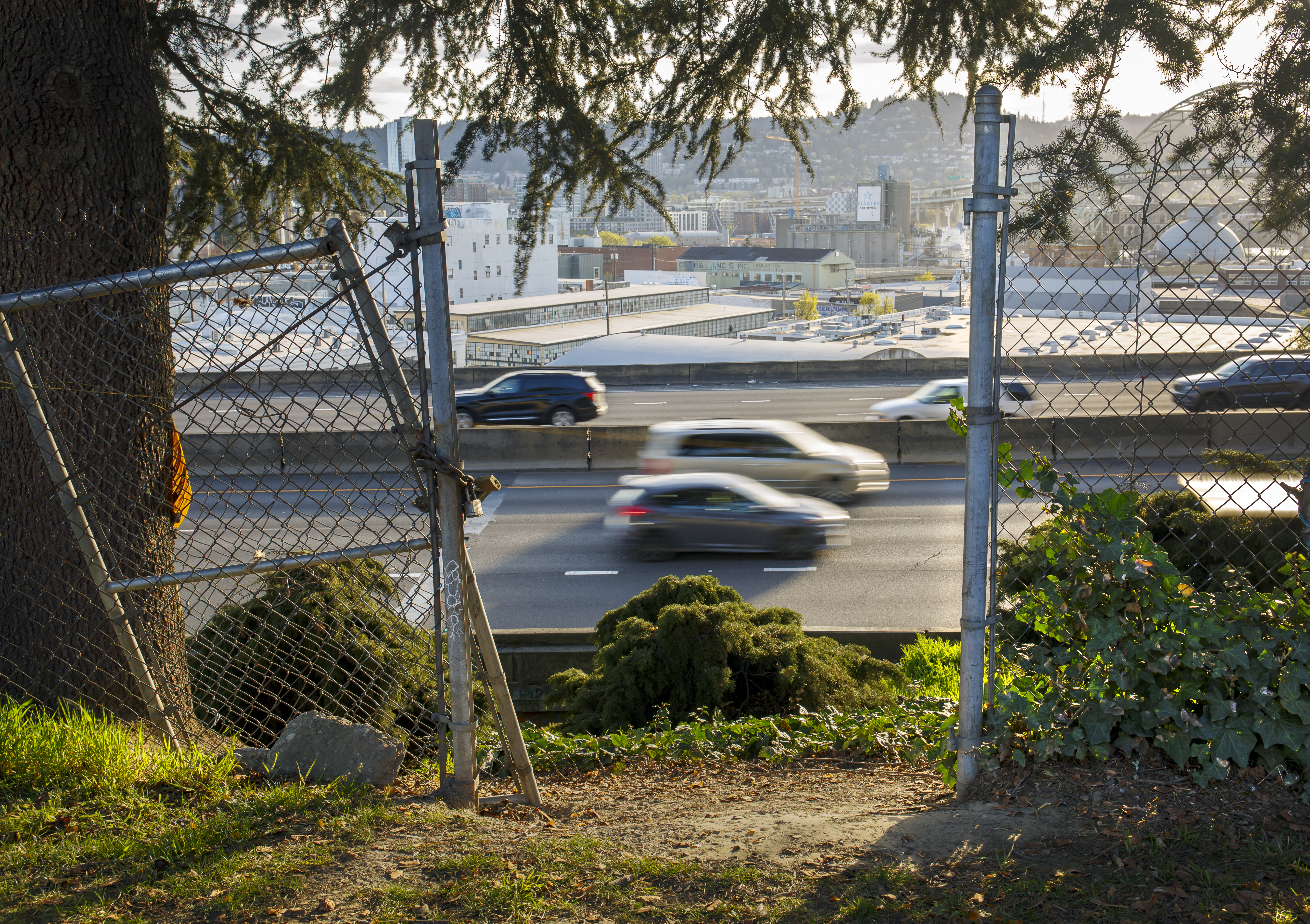Since opening as a new middle school three years ago, North Portland’s Harriet Tubman building has had an uneasy coexistence with the oft-congested interstate highway about 50 feet to the west.
Students with asthma opt-out of recess on smoggy days. A top-of-the-line HVAC system rids the air of the pollutants that seep in. Students are kept away from the freeway-facing side of the building.
“We would not be allowed where those snack tables are,” said former student Malina Yuen, one of a few hundred that gathered at the school Friday to rally against a controversial plan by the state’s transportation agency to widen a leg of freeway that winds through Portland’s Rose Quarter. “Never.”
She pointed just beyond the school’s entryway.
Those boundaries may soon need to change. A newly surfaced map shows the Oregon Department of Transportation wants to move the freeway so close to the school that the agency will need to take over some of the campus.

A blue line shows the rough boundaries of Portland Public Schools' property, with Harriet Tubman Middle School in the center. A yellow shaded area shows the approximate portion of the property ODOT would take as part of the freeway-widening project.
Rebecca Ellis / OPB and portlandmaps.com
The map, obtained by the advocacy group No More Freeways PDX through a public records request, shows ODOT plans on taking a portion of the Tubman school grounds for the freeway shoulder and constructing a noise wall across the property as part of a project to widen the freeway. At the closest point, near the southern edge of the Portland Public Schools property line, the noise wall would be less than 25 feet away from the school building, according to the map.
The widening project would add new lanes to a leg of freeway stretching from the Fremont Bridge to the Interstate 84 interchange. ODOT says the project, now estimated to cost $800 million, is necessary to relieve congestion and will improve air quality around the school. Critics maintain the project will have the opposite effect, encouraging more drivers to take the freeway and increasing greenhouse gas emissions near a school predominantly attended by students of color.
The map detailing the plan for the PPS property was first created over two years ago, but had not been seen by the school board until a few weeks ago, according to a board member.
ODOT spokesperson Tia Williams confirmed the analysis. Williams said the map was the most up-to-date rendering of the agency’s plan for the property, but emphasized ODOT is just a fifth of the way done with the project design and the plan could change.
“This is history continuing to repeat itself,” said Aaron Brown, a spokesperson with No More Freeways PDX. “The North Portland neighborhood has dealt with systemic racism and redlining and environmental injustices for decades.”

Michelle DuBarry and her daughter Greta, 8, attend a rally held at Harriet Tubman Middle School in North Portland, April 9, 2021, opposing ODOT's Rose Quarter expansion project that would bring the I-5 freeway even closer to the school. No More Freeways, Eliot Neighborhood Association and Neighbors for Clean Air and filed a lawsuit against the project.
Kristyna Wentz-Graff / OPB
Tubman was first used as a middle school in the ’80s after the freeway, along with other urban renewal projects, had decimated the historically Black neighborhood of lower Albina. The school district shut down the site in 2012 due to low student enrollment, but reopened it in 2018 as part of an effort to improve educational disparities in the school system. According to enrollment information from that year, fewer than 500 students attended the school. Forty percent of students were Black.
The encroaching freeway has thrown the viability of the school into question once again. Scott Bailey, a Portland Public School board member, said he believes a freeway abutting the middle school could force them out of the facility.
“Now, with them moving even closer, it just calls into question: are kids safe in front of the building?” said Bailey.
He ballparks the cost of a new middle school at about $80 million — a cost he believed should be borne by the transportation agency encroaching on their campus. He notes the school has already spent about $12 million on industrial air filters and banned students from playing behind the building due to concerns over hazardous air quality.
“At a certain point, it means we have to move,” he said. “We have to relocate a school.”

A rally held at Harriet Tubman Middle School in North Portland, April 9, 2021, opposing ODOT’s Rose Quarter expansion project that would bring the I-5 freeway even closer to the school. No More Freeways, Eliot Neighborhood Association and Neighbors for Clean Air and filed a lawsuit against the project.
Kristyna Wentz-Graff / OPB
Linda George, a professor of environmental science and management at Portland State University, co-authored a report on air quality at the school in 2018. She said the purifiers purchased by the school have bestowed the inside of the building with some of the healthiest air in Portland — so clean that she recommended the district use the school as a clean air shelter during smoke events. But she said there’s little the school district or ODOT can do to purify the air outside.
“There’s really nothing to be done about that. People have tried trees and sound wall and things like that, but all that depends on wind direction. You just never know how effective it’s going to be,” she said. “There’s really nothing to do for the play area — and kids are out there.”
The Portland Public School board voted to oppose the highway project in 2019 if the state failed to conduct a detailed environmental impact study that would delve into the effects the expansion would have on students. The agency opted instead to do a basic review called an environmental assessment.
Focused on school closures and reopening amid the pandemic, PPS has yet to take another stance on the freeway fight. But at a board meeting last Thursday, board member Julia Brim-Edwards recommended the board weigh in again — this time, on the potentially devastating impact the expansion would have on the middle school.

Aaron Brown speaks at a rally held at Harriet Tubman Middle School in North Portland, April 9, 2021, opposing ODOT's Rose Quarter expansion project that would bring the I-5 freeway even closer to the school. No More Freeways, Eliot Neighborhood Association and Neighbors for Clean Air and filed a lawsuit against the project.
Kristyna Wentz-Graff / OPB
“We need to have a point of view as a district that this project … if it proceeds, is going to really make that site not an appropriate site long-term for a school,” said Brim-Edwards.
Williams, an ODOT spokesperson, said Portland Public Schools would have final say through a vote on whether it wants a noise wall to block out the sounds of the nearby freeway. But ODOT, able to wield the power of eminent domain, would likely have final say on taking the property.
Amy Kohnstamm, another board member, recommended the board focus on coming up with a valuation for the property and ask ODOT to buy them out. Board members suggested they start refocusing on the debate over the freeway next month.
“I would like to free us up from this sort of bureaucratic morass and make our position really clear,” said Kohnstamm. “We know that this is going to have an intolerable impact for our students.”

ODOT's project map for I-5 widening near Harriet Tubman school. The key things to note here are the purple "permanent impacts" lines and the red cross-hatched pattern of "permanent takes."
ODOT

